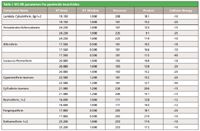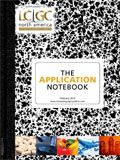Screening for Pyrethroid Insecticides in Sediment Samples by GC–MS-MS
A simple screening method for Pyrethroid insecticides in sediment samples is described. Electron impact ionization (EI) with tandem MS-MS in combination with programmed temperature vaporization injection (PTV) were used in order to obtain excellent specificity and low limits of detection.
A simple screening method for Pyrethroid insecticides in sediment samples is described. Electron impact ionization (EI) with tandem MS-MS in combination with programmed temperature vaporization injection (PTV) were used in order to obtain excellent specificity and low limits of detection.
Pyrethroids are synthetic chemical insecticides whose chemical structures were adapted from the chemical structures of the pyrethrins. Pyrethroids have been modified to increase their stability in sunlight. They are toxic to aquatic organisms at extremely low concentrations, especially to invertebrates that are at the bottom of the food chain (1). Many of the compounds end up in wastewater outfalls due to ineffective water treatment. As a result, state and federal agencies have initiated monitoring programs to characterize the extent of contamination in water supplies and their potential impact on aquatic life. In general, there are no set requirements for minimum detection or reporting levels. However, the lowest reporting level that can be achieved by a given technique is desired.

Table I: MS-MS parameters for pyretroids insecticides
The Scion TQ triple quadrupole mass spectrometer in EI mode with PTV injection is ideal for screening sediment extracts at low to sub-part-per-billion concentrations.
Experimental
451-GC Gas Chromatographic Conditions
Column: BR-5ms, 30 m × 0.25 mm × 0.25 µm
Column Flow Rate: 1.0 mL/min constant flow
Injector: Bruker PTV injector, with 3.4 mm ID Siltek Fritted Liner
Injector Conditions: 60 °C hold 0.4 min to 310 °C at 200 °C/min, hold 30 min
Column Temperature Program: 55 °C, hold 3 min, ramp to 200 °C at
40 °C/min, hold 1 min; ramp to
310 °C at 5 °C/min, hold 1 min
Injection: 8.0 µL using Bruker 8400 auto sampler
Scion TQ MS Conditions
Scion TQ MS Conditions
Ion Source Temperature: 250 °C
Transferline Temperature: 280 °C
Filament Delay time: 12 min
Filament Emission Current: 80 µA
Dwell Time: 100 ms each transition
Calibration standards in hexane were prepared at 0.1, 1, 5, 10, 25, 50, 100, and 200 ppb. In addition, a blank sediment matrix was spiked at concentrations of 0.5, 5, 10, 25, 50, 100, and 200 ppb.
Sample preparation: 5 g copper powder/magnesium sulfate was added to 20 g wet sediment. The mixture was extracted with 2 × 75 mL 50:50 acetone:hexane using a shaker at 185 rpm (2 × 15 min). The extracts were concentrated to a final volume of 2 mL and cleaned up on Florisil® Sep Pak.
Results
The Scion TQ has a unique software feature known as Compound Based Scanning (CBS) that was used to easily set up the MRMs required for the analysis. The pyrethroids were found in the Factory Library within the CBS software, and were directly downloaded into the scan acquisition method (Figure 1). In addition, the data handling table is automatically created and linked to the scan acquisition method. This saves time because the operator does not have to create additional tables and manage changes to the analytical method.

Figure 1
The use of MS-MS provided excellent sensitivity and specificity for the analysis. Compounds detected in the sediment sample spiked at 0.5 ppb are shown in Figure 2.

Figure 2
Calibration curves prepared in pure solvent (hexane) and in blank sediment extracts were linear indicating no matrix interference from the sediment extract.
Conclusion
PTV injection combined with the sensitivity and specificity of MS-MS result in excellent low-level screening of pyrethroids in river and lake sediments.
The Scion TQ with Compound Based Scanning allows easy set-up and management of the pyrethroid MRM parameters. Compound MRM information is loaded directly into the method by choosing them from a factory or user created library. It links the mass spectrometer acquisition table directly with data handling parameters, streamlining the data process.
Acknowledgements
California Department of Food and Agriculture (http://www.cdfa.ca.gov/)
Reference
(1) http://www.beyondpesticides.org/pesticides/factsheets/Synthetic%20Pyrethroids.pdf
Bruker Daltonics, Chemical Analysis Division
Billerica, MA
tel. (978) 663-3660, fax (978) 667-5993
Website: www.bruker.com

Follow the Data to Grow: Why a Scientific Data Platform is Essential
October 28th 2024Innovation is the engine that powers a company’s growth and product development, and for enterprises with R&D laboratories, those lab environments are the greatest source of this innovation. In this white paper, learn how a platform approach to scientific data management, including semantic search, advanced analytics, and lab automation, leads to better enterprise decisions at the executive level, optimized lab performance, more discoveries, and stronger product pipelines.
















